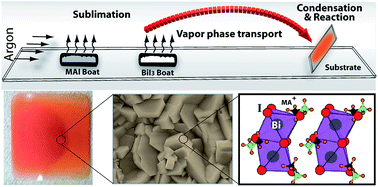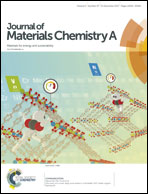Atmospheric pressure chemical vapor deposition of methylammonium bismuth iodide thin films†
Abstract
We demonstrate the atmospheric pressure chemical vapor deposition of methyl ammonium bismuth iodide ((CH3NH3)3Bi2I9 or MA3Bi2I9) films. MA3Bi2I9 possesses an indirect optical bandgap of 1.80 eV and a room temperature excitonic peak at 511 nm. In contrast to recent reports, the films are n-type semiconductors with a room temperature carrier concentration of 3.36 × 1018 cm−3 and a Hall mobility of 18 cm2 V−1 s−1, which are superior to those of solution-processed, undoped films. The precursors used for the deposition are methylammonium iodide and bismuth iodide which are co-sublimated at 199 °C and 230 °C, respectively, in an Ar flow inside a tube furnace with a variable temperature profile. The substrate temperature is set at 160 °C, and dense polycrystalline films (∼775 nm thick) are deposited. Extensive characterization combined with first-principles density functional theory calculations unravels the synthesis–structure–property relationship in these films. The degradation of properties under ambient conditions results from film oxidation with a characteristic bi-exponential decay in resistivity, signifying a fast surface oxidation followed by a slower oxidation of the bulk.



 Please wait while we load your content...
Please wait while we load your content...